-
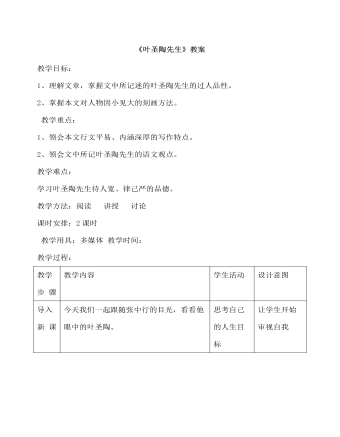
部编版语文七年级下册《叶圣陶先生》教案
一、 作者介绍 张中行,原名张璇,学名张璿,河北省香河县河北屯乡石庄(今属天津市武清区河北屯镇)人,著名学者、哲学家、散文家。主要从事语文、古典文学及思想史的研究。曾参加编写《汉语课本》、《古代散文选》等。合作编著有《文言文选读》、《文言读本续编》;编著有《文言常识》、《文言津逮》、《佛教与中国文学》、《负暄琐话》等。是二十世纪末未名湖畔三雅士之一,与季羡林、金克木合称“燕园三老”。季羡林先生称赞他为“高人、逸人、至人、超人”。 二、初读课文 自由阅读课文,理解重点词句搀和:chān huo 掺杂混合 东四八条:北京东城区胡同名 冗长:rǒng cháng (文章、讲话等)废话多,拉得很长,含贬义 著作等身:形容著作极多,叠起来能跟作者的身高相等。 沾溉:浸润浇灌 高文典册:经典性著作 躬行君子,则吾未之有得:做一个身体力行的君子,那我还没有做到。
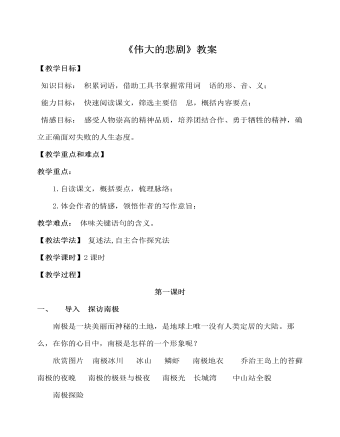
部编版语文七年级下册《伟大的悲剧》教案
千百年来,南极这个亘古长眠的世界一面向世人展示着自己冰肌玉骨、绝世无双的美丽,一面以其层层冰嶂、酷冷奇寒的肃杀之气凛然回绝了人类无数次好奇的拜访。因为那里的天气实在是太恶劣了。而近百年来,无数探索者在南极留下了他们的足迹,他们为人类的进步事业作出了自己的贡献,有的甚至献出了宝贵的生命。1911年,两位著名的探险家挪威人阿蒙森和英国人斯科特踏上了冲击南极点的征程。这两个人都想成为第一个到达南极点的英雄。经过一番激烈的竞争,结果是阿蒙森队捷足先登,于1911年12月14日到达南极,而斯科特队则于1912年1月18日才到达,比阿蒙森队晚了将近五个星期。最后,阿蒙森胜利而归,成功的旗帜永远飘扬在南极点上,而斯科特等五名冲击南极的英雄,因为南极寒冷天气的突然提前到来,饥寒交迫,体力不支,在返回的途中与严寒搏斗了两个多月,最后长眠在茫茫的冰雪之中。
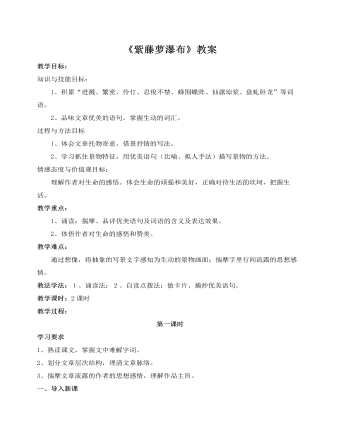
部编版语文七年级下册《紫藤萝瀑布》教案
学习要求1、熟读课文,掌握文中难解字词。2、划分文章层次结构,理清文章脉络。3、揣摩文章流露的作者的思想感情,理解作品主旨。一、导入新课紫藤萝亦称紫藤,朱藤,藤萝,豆科,羽状复叶,春季开花,蝶形花冠,青紫色,总状花序,产于我国中部,供观赏,花种子供食用。紫藤萝是瀑布吗?不是的,因为,它是很多很多的紫藤萝花组成的,因为像瀑布一样从空中垂下来,不见其发端,也不见其终极,所以文章叫《紫藤萝瀑布》。 二、作者简介宗璞,原名冯宗璞,我国当代女作家,毕业于清华大学文学系。我们学过的文章有童话《花的话》。本文背景宗璞一家,在“文化大革命”中深受迫害,“焦虑和悲痛”“一直压在”作者的心头。这篇文章写于1982年5月,当时作者的小弟身患绝症,作者非常悲痛(1982年10月小弟病逝),徘徊于庭院中,见一树盛开的紫藤萝花,睹物释怀,由花儿的自衰到盛,感悟到生的美好和生命的永恒,于是写成此文。
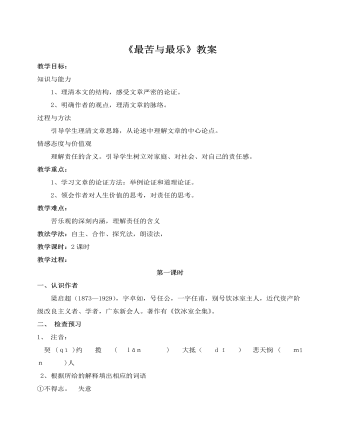
部编版语文七年级下册《最苦与最乐》教案
② 什么事最快乐呢?(用原文语句回答)责任完了,算是人生第一件乐事。③用文中语句概括第4自然段的内容。天下事从苦中得来的乐才算真乐。④请从最后一段中找出与“快乐之权,操之在己”内涵相符的一句:尽得大的责任,就得大快乐;尽得小的责任,就得小快乐。第二课时四、师生探究讨论第一部分:1、文章开头设问“人生什么事最苦?”提到了哪些事,它们是最苦的事吗?贫→知足;失意→安分;老、死→达观。作者认为它们可以从心态上、观念上去排解。2、接着作者提出自己的见解,人生什么事最苦呢? (请用原文回答)我说人生最苦的事,莫若身上背着一种未了的责任。3、作者举了哪些例子证明自己的观点?从个人对他人的责任(承诺未完、欠人钱、受人恩惠、得罪人等)再延伸到对家庭、社会、国家,乃至于对自己都有责任,一旦应尽的责任没有尽,这种痛苦无法解脱。
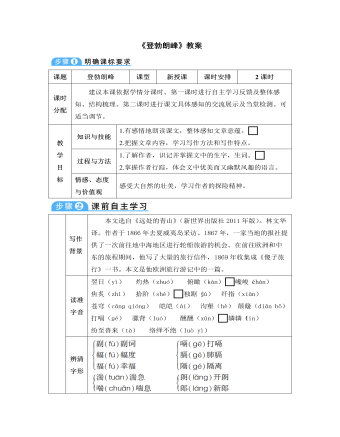
部编版语文八年级下册《登勃朗峰》教案
【初读课文,整体感知】1.文章主要描写了作者上山与下山的经历,这些经历有哪些不同?表达了作者什么样的感受?(1)作者上山时,是以写景散文的笔法,描述了沿途的秀色美景,高山的险峻陡峭,水流的清澈急湍,美不胜收。表达了作者游览时的激动与喜悦。(2)作者下山时,是以叙述小说的笔法,用极为幽默诙谐的写法描述了车夫之王,以及他们惊险而又激动的旅行,富有感染力和传奇色彩。2.本文第4、5段的描写十分精彩,试分析其表达特色和表达效果。选取勃朗峰上的山峰、高地,从视觉的角度描写,远近结合,相映成趣。运用比喻、拟人的修辞手法,生动形象地描绘了陡峭峻拔的山峰、色彩斑斓的天空、飘忽不定晶莹洁白的白云,体现了勃朗峰景色的优美壮丽。
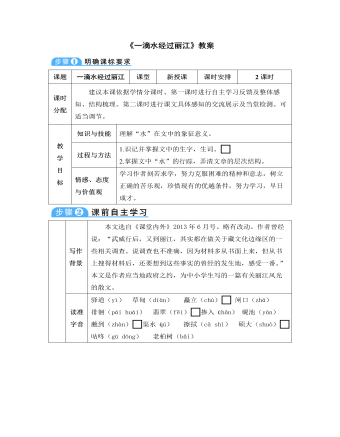
部编版语文八年级下册《一滴水经过丽江》教案
【感悟精彩句子】1. “今天,一架大水车来把我们扬到高处,游览古城的人要把这水车和清凉的水作一个美丽的背景摄影留念。”写到大水车的用意是什么? 大水车是丽江古城的标志性建筑,成为了丽江古城的地标,也是游客们一定要去拍照留念的地方。历史足迹明显,地域特色突出。2. 一些薄云掠过月亮时,就像丽江古城中,一个银匠,正在擦拭一只硕大的银盘。联想,古城的民俗难以忘怀。3.“我知道,作为一滴水,我终于以水的方式走过了丽江。”这样的结尾,体现了一滴水怎样的情怀?〖ZK)〗欣赏了风景如画的丽江,考察了“土”味浓郁的建筑,体会了丰富多彩的民俗民风,美感袭身,皆满足矣。融入更加广阔的江海,开始一滴水热情、奔放的新生活。
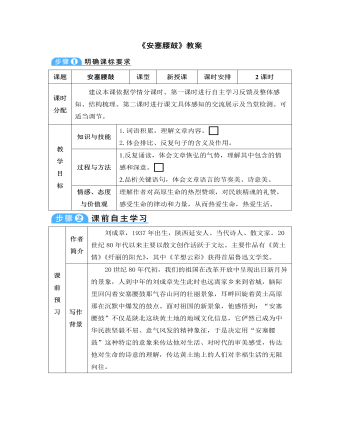
部编版语文八年级下册《安塞腰鼓》教案
3.“多水的江南是易碎的玻璃,在那儿,打不得这样的腰鼓。”为什么说“多水的江南”打不得这样的腰鼓?江南流水更多地是表现柔媚的风格,而安塞腰鼓需要承载原始、粗犷的生命力量的“厚土”。4.“耳畔是一声渺远的鸡啼”,为什么听到这样的“鸡啼”?当鼓声停止后,人们仍沉浸在激情中,好像炽热后的沉寂,这时以“鸡啼”反衬寂静。5.西北现在好像成了贫困落后的代名词,作者为什么这样歌颂西北汉子?西北,是中华民族的主要发源地,曾有过秦、汉、唐的强盛,拥有雄睨世界的辉煌文明。在今天,凝重的土地,贫困的生活,西北好像落伍了。但是,“消化着红豆角角老南瓜”的躯体,并没有因生活的贫苦和封闭而丧失希望,复生的生命能量就在这沉重的躯壳内奔突,终有一天会喷发的。这里的人们是有希望的,这里的土地是有希望的。
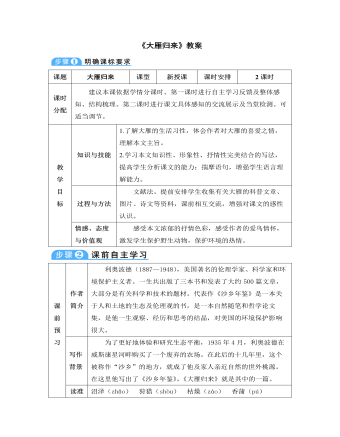
部编版语文八年级下册《大雁归来》教案
【初读课文,整体感知】1.作者笔下的大雁有哪些特点?①飞来的季节是三月春天;②飞行的路线是笔直的;③三月的大雁一触到水就叫,就喧嚷;④十一月份的大雁一声不响;⑤爱寻食玉米粒;⑥常成六只或六的倍数列队飞;⑦四月的夜间,大雁会一阵阵喧闹。2.快速阅读课文,找出文中描写大雁的句子,体会其作用。例如:①而一只定期迁徙的大雁,下定了在黑夜飞行20英里的赌注,它一旦起程再要撤回去可就不那么容易了。②乌鸦通常被认为是笔直飞行的,但与坚定不移地向南飞行200英里直达最近的大湖的大雁相比,它的飞行也就成了曲线。③它们顺着弯曲的河流拐来拐去,穿过现在已经没有猎枪的狩猎点和小洲,向每个沙滩低语着,如同向久别的朋友低语一样。④第一群大雁一旦来到这里,它们便向每一群迁徙的雁群喧嚷着发出邀请。⑤那接着而来的低语,是它们在论述食物的价值。

部编版语文八年级下册《壶口瀑布》教案
黄河有令人震撼的刚强的一面,也有如歌如画的柔美的一面——刚柔相济。【品味亮点词语】1.壶口瀑布不是从高处落下,让人们仰观垂空的水幕,而是由平地向更低的沟里跌去,人们只能俯视被急急吸去的水流。“吸”,壶口之水的气势、能量尽显无遗,省去了不少渲染的笔墨。2.于是,只急慌慌地扫了几眼,我便匆匆逃离,到了岸上回望那团白烟,心还在不住地跳…… “急慌慌”“匆匆”“不住地”,用“我”的瞬间系列感观衬托瀑布之险,回应了段首中心句。3.黄河在这里由宽而窄,由高到低,只见那平坦如席的大水像是被一个无形的大洞吸着,顿然拢成一束,向龙槽里隆隆冲去,先跌在石上,翻个身再跌下去,三跌,四跌,一川大水硬是这样被跌得粉碎,碎成点,碎成雾。一连串的“跌”字,把瀑布的来势之猛、落差之大表现得淋漓尽致。
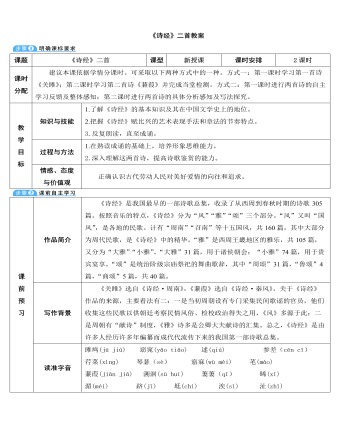
部编版语文八年级下册《诗经》两首教案
【深入研读,探究方法】《关雎》1.双声叠韵。用双声叠韵的联绵词来增强诗歌音调的和谐美和描写人物的生动性。如“窈窕”,是叠韵;“参差”,是双声;“辗转”,既是双声又是叠韵。用各类词语修饰动作,如“辗转反侧”;摹拟形象,如“窈窕淑女”;描写景物,如“参差荇菜”,无不活泼逼真、声情并茂。2.偶句入韵。这种偶韵式支配着两千多年来我国古典诗歌谐韵的形式,而且全篇三次换韵,又有虚字脚“之”字不入韵,而以虚字的前一字为韵。这种在用韵方面的参差变化,极大地增强了诗歌的节奏感和音乐美。3.起兴手法。起兴,作为《诗经》中经常使用的一种表现手法,就是触景生情,因事寄兴。一般用于一首诗的开头,先用一两句话写一下周围景物,以引起下面的诗句。比如这首诗写雎鸠鸣叫,让人联想到男女欢爱,引出下文追求淑女的诗句。
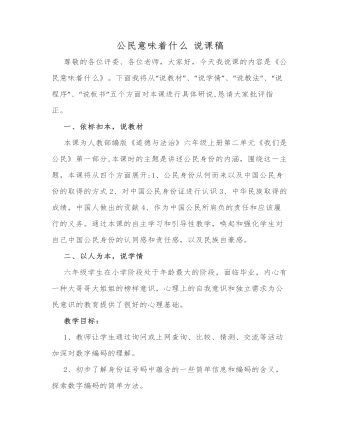
公民意味着什么 说课稿
一、依标扣本,说教材本课为人教部编版《道德与法治》六年级上册第二单元《我们是公民》第一部分,本课时的主题是讲述公民身份的内涵,围绕这一主题,本课将从四个方面展开:1、公民身份从何而来以及中国公民身份的取得的方式2、对中国公民身份证进行认识3、中华民族取得的成绩,中国人做出的贡献4、作为中国公民所肩负的责任和应该履行的义务。通过本课的自主学习和引导性教学,唤起和强化学生对自己中国公民身份的认同感和责任感,以及民族自豪感。二、以人为本,说学情六年级学生在小学阶段处于年龄最大的阶段,面临毕业,内心有一种大哥哥大姐姐的榜样意识,心理上的自我意识和独立需求为公民意识的教育提供了很好的心理基础。教学目标:1、教师让学生通过询问或上网查询、比较、猜测、交流等活动加深对数字编码的理解。2、初步了解身份证号码中蕴含的一些简单信息和编码的含义,探索数字编码的简单方法。3、通过编码的应用使学生体会到数学与现实生活联系紧密,从而培养学生对数学的学习兴趣。
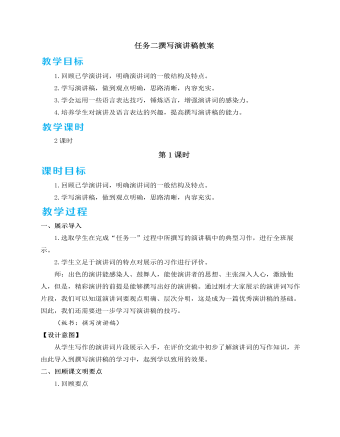
人教部编版语文八年级下册任务二撰写演讲稿教案
[乙]爱是人世间最完美的一种情感,爱就像一缕冬日里的阳光,能让饥寒交迫的人感到温暖;爱就像一泓沙漠中的清泉,能使濒临绝境的人看到希望;爱就像一盏黑暗中的路灯,能让迷惘的人找到方向。我们要让爱永驻心中,哪怕只是对父母的一句“我爱你们”、对朋友的一句“加油”、对摔倒老人的一次伸手。多一份行动,多一份传递,多一种信念,尽自己的微薄之力去帮助他人,回报社会,让爱的种子飞得更远更广,永远地扎根于人们的心中!(生交流讨论)预设 乙结尾运用了比喻、排比等修辞手法,语言更加生动,富于表现力,尤其是排比句的运用,使得句式整齐、有气势,情感表达有感染力。另外,结尾段不断重申观点,也起到了加深听众印象的效果。师:除了运用修辞手法之外,根据演讲稿的特点,我们还可以从哪些方面锤炼语言来增强演讲的表达效果呢?(生结合演讲稿的特点,讨论交流)预设 (1)运用一些口语、大众化的语言,拉近与听众的距离。(2)多用短句,少用结构复杂的长句,使语意清晰,简短易懂。

人教部编版七年级下册综合性学习我的语文生活教案
1.培养学习语文的兴趣,感悟生活处处皆语文的道理。2.了解招牌、广告词和对联。3.按兴趣分组,制定活动计划。 一、导入新课师:同学们,我们学习语文都有哪些途径呢?(生:课本、课堂。)除此之外,老师认为还可以通过以下途径来学习语文。从媒体中学语文——网络用语、手机短信、歌词等;从名字中学语文——人名、地名等;向群众学语文——俗语、谚语、歇后语等;从传统文化中学语文——对联……从广告中学语文——商业广告、公益广告…… 师:无论是读书看报、与人聊天,还是听相声、看电视、逛商场,只要留心观察,随时注意语言现象,总会发现与语文有关的问题。书本上、电视上、报纸上满是汉字。大街上的招牌、广告、门对等全都充满语文气息。语文学习不能局限于课堂与书本,生活处处有语文。今天,我们就来开展综合性学习活动“我的语文生活”,看看怎样在生活中学习语文。
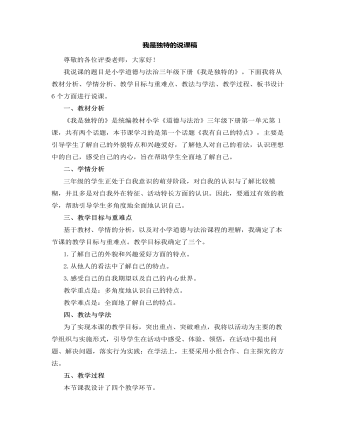
人教部编版道德与法制三年级下册我是独特的说课稿
学生阅读教材第5页阅读角,感受故事中主人翁的内心世界,再想一想“我的故事袋”中都装着哪些事情,其中有能够公开的,与大家分享。设计意图:深入感受自己丰富、独特的内心世界。环节三:感悟明理,育情导行学生谈一谈学习本节课的收获,教师相机引导。设计意图:梳理总结,体验收获与成功的喜悦,内化提升学生的认识与情感。环节四:拓展延伸,回归生活回家后,向爸爸妈妈讲一讲独特的自己。设计意图:将课堂所学延伸到学生的日常生活中,有利于落实行为实践。六、板书设计为了突出重点,让学生整体上感知本节课的主要内容,我将以思维导图的形式设计板书:在黑板左半面的中间位置是课题《我是独特的》,右半面分四行,找一找自己、他人眼中的自己、期望中的自己、我独特的内心世界。其中,找一找自己分为两方面:外貌 独一无二 本领 各不相同;他人眼中的自己,我认可。
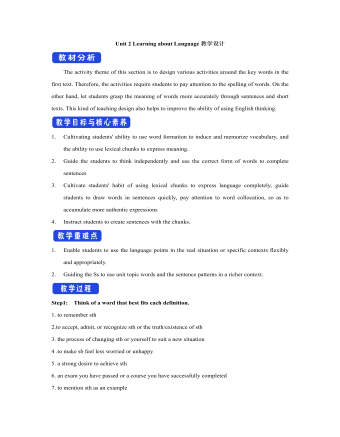
新人教版高中英语选修2Unit 2 Learning about Language教学设计
The activity theme of this section is to design various activities around the key words in the first text. Therefore, the activities require students to pay attention to the spelling of words. On the other hand, let students grasp the meaning of words more accurately through sentences and short texts. This kind of teaching design also helps to improve the ability of using English thinking.1. Cultivating students' ability to use word formation to induce and memorize vocabulary, and the ability to use lexical chunks to express meaning.2. Guide the students to think independently and use the correct form of words to complete sentences3. Cultivate students' habit of using lexical chunks to express language completely, guide students to draw words in sentences quickly, pay attention to word collocation, so as to accumulate more authentic expressions4. Instruct students to create sentences with the chunks.1. Enable students to use the language points in the real situation or specific contexts flexibly and appropriately.2. Guiding the Ss to use unit topic words and the sentence patterns in a richer context.Step1: Think of a word that best fits each definition.1. to remember sth2.to accept, admit, or recognize sth or the truth/existence of sth3. the process of changing sth or yourself to suit a new situation4 .to make sb feel less worried or unhappy5. a strong desire to achieve sth
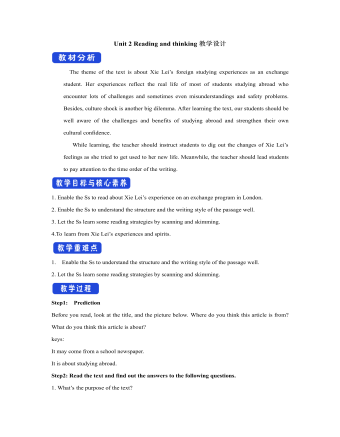
新人教版高中英语选修2Unit 2 Reading and thinking教学设计
Her tutor told her to acknowledge __________ other people had said if she cited their ideas, and advised her _______(read) lots of information in order to form __________wise opinion of her own.Now halfway __________ her exchange year, Xie Lei felt much more at home in the UK. She said __________ (engage) in British culture had helped and that she had been__________ (involve) in social activities. She also said while learning about business, she was acting as a cultural messenger __________(build) a bridge between the two countries. keys:Xie Lei, a 19yearold Chinese student, said goodbye to her family and friends in China and boarded (board) a plane for London six months ago in order to get a business qualification. She was ambitious(ambition) to set up a business after graduation. It was the first time that she had left (leave) home.At first, Xie Lei had to adapt to life in a different country. She chose to live with a host family, who can help with her adaptation (adapt) to the new culture. When she missed home, she felt comforted (comfort) to have a second family. Also Xie Lei had to satisfy academic requirements. Her tutor told her to acknowledge what other people had said if she cited their ideas, and advised her to read lots of information in order to form a wise opinion of her own.Now halfway through her exchange year, Xie Lei felt much more at home in the UK. She said engaging (engage) in British culture had helped and that she had been involved (involve) in social activities. She also said while learning about business, she was acting as a cultural messenger building a bridge between the two countries.
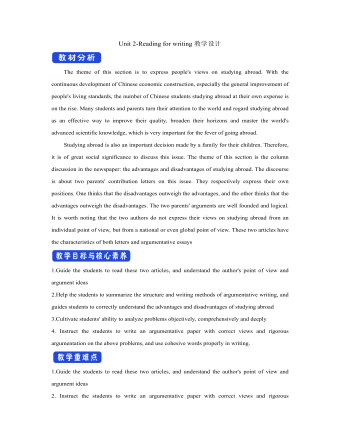
新人教版高中英语选修2Unit 2 Reading for writing教学设计
The theme of this section is to express people's views on studying abroad. With the continuous development of Chinese economic construction, especially the general improvement of people's living standards, the number of Chinese students studying abroad at their own expense is on the rise. Many students and parents turn their attention to the world and regard studying abroad as an effective way to improve their quality, broaden their horizons and master the world's advanced scientific knowledge, which is very important for the fever of going abroad. Studying abroad is also an important decision made by a family for their children. Therefore, it is of great social significance to discuss this issue. The theme of this section is the column discussion in the newspaper: the advantages and disadvantages of studying abroad. The discourse is about two parents' contribution letters on this issue. They respectively express their own positions. One thinks that the disadvantages outweigh the advantages, and the other thinks that the advantages outweigh the disadvantages. The two parents' arguments are well founded and logical. It is worth noting that the two authors do not express their views on studying abroad from an individual point of view, but from a national or even global point of view. These two articles have the characteristics of both letters and argumentative essays1.Guide the students to read these two articles, and understand the author's point of view and argument ideas2.Help the students to summarize the structure and writing methods of argumentative writing, and guides students to correctly understand the advantages and disadvantages of studying abroad3.Cultivate students' ability to analyze problems objectively, comprehensively and deeply
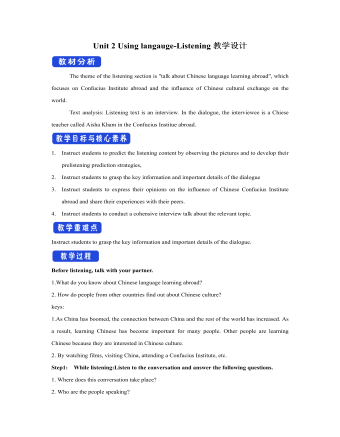
新人教版高中英语选修2Unit 2 Using langauge-Listening教学设计
? B: Absolutely! Getting involved with Chinese cultural activities there definitely helped a lot. I got to practice my Chinese on a daily basis, and I could learn how native Chinese speakers spoke.? A: What do you feel is your biggest achievement?? B: Learning Chinese characters! I have learnt about 1,500 so far. When I first started, I didn't think it was even going to be possible to learn so many, but now I find that I can read signs, menus, and even some easy newspaper articles.? A: What are you most keen on?? B: I've really become keen on learning more about the Chinese culture, in particular Chinese calligraphy. As I have learnt Chinese characters, I have developed a great appreciation for their meaning. I want to explore Chinese characters by learning how to write them in a more beautiful way. ? A: Finally, what do you want to say to anyone interested in learning Chinese?? I have really become keen on learning more about the Chinese culture, in particular Chinese Calligraphy. As I have learnt Chinese character, I have developed a great appreciation for their meaning. I want to explore Chinese characters by learning how to write them in a more beautiful way.? A: Finally, what do you want to say to anyone interested in learning Chinese?? B: I'd say, give it a shot! While some aspects may be difficult, it is quite rewarding and you will be happy that you tried.? A: Thanks for your time. ? B:You're welcome.

新人教版高中英语必修3Unit 2 Morals and Virtues教学设计四
3.Teachers ask different groups to report the answers to the questions and ask them to try different sentence patterns.The teacher added some sentence patterns for students to refer to when writing.Step 4 Writing taskActivity 51.Write the first draft.Students first review the evaluation criteria in activity 5, and then independently complete the draft according to the outline of activity 4, the answers to the questions listed in the group discussion and report, and the reference sentence pattern.2.Change partners.The teacher guides the students to evaluate their partner's composition according to the checklist of activity 5 and proposes Suggestions for modification.3.Finalize the draft.Based on the peer evaluation, students revise their own compositions and determine the final draft.Finally, through group recommendation, the teacher selects excellent compositions for projection display or reading aloud in class, and gives comments and Suggestions.Step 5 Showing writingActivity 5T call some Ss to share their writing.Step 6 Homework1. Read the passage in this section to better understand the passage.2. Carefully understand the hierarchical structure of the article, and deeply understand the plot of the story according to the causes, process and results;3. Independently complete the relevant exercises in the guide plan.1、通过本节内容学习,学生是否理解和掌握阅读文本中的新词汇的意义与用法;2、通过本节内容学习,学生能否通过人物言行的对比分析道德故事的深层内涵;3、通过本节内容学习,学生能否根据故事的起因、经过和结果来深入理解故事的情节,从而了解文章的层次结构;4、结合现实生活案例发表自己的见解和看法,写一篇观点明确、层次分明的故事评论。

新人教版高中英语必修3Unit 2 Morals and virtues教学设计一
(2) students are divided into groups according to the requirements of activity 3. Each student shares a story of personal experience or hearing-witnessing kindness, and then selects the most touching story in the group and shares it with the whole class. Before the students share the story, the teacher can instruct them to use the words and sentence patterns in the box to express. For example, the words in the box can be classified:Time order: first of all, then, after that, later, finally logical relationship :so, however, although, butTeachers can also appropriately add some transitional language to enrich students' expression:Afterwards, afterwards, at last, in the end, eventuallySpatial order: next to, far from, on the left, in front ofOtherwise, nevertheless, as a result, therefore, furthermore, in addition, as well asSummary: in a word, in short, on the whole, to sum up, in briefStep 8 Homework1. Understand the definition of "moral dilemma" and establish a correct moral view;2. Accumulate vocabulary about attitudes and emotions in listening texts and use them to express your own views;3. Complete relevant exercises in the guide plan.1、通过本节内容学习,学生能否理解理解“道德困境”的定义;2、通过本节内容学习,学生能否通过说话人所表达的内容、说话的语气、语调等来判断其态度和情绪;3、通过本节内容学习,学生能否针对具体的道德困境发表自己的看法和见解,能否掌握听力理训练中的听力策略。

